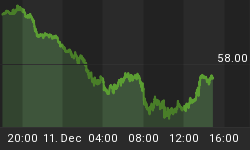The dollar is no longer responding to traditional stimulants. This week, despite the apparently "hawkish" tone in the recently released Fed minutes, and trade deficit figures that were slightly less horrific than expected, the dollar nevertheless declined against just about every currency on the planet. As a result, it now teeters dangerously close to the edge of a very large precipice. Looming large is the 80 level of the U.S. Dollar Index which has stood as long term support for almost thirty years. This week, the Index broke below 82, and is sinking fast. When this critical level is breached, look out below. Without any support beneath it, the dollar could literally fall off a cliff.
The trajectory of the dollar is linked to America's economic status in the world. Last week we learned, thanks in part to the strengthening euro, that the market capitalization of European shares now exceeds the market capitalization of American shares for the first time since before the First World War. At the current rate of appreciation, European shares will have a market cap 50% greater than American shares by the end of the decade. However, should the dollar decline turn into a free fall, this could happen much sooner.
For individual currencies, the British pound warrants particular attention as it approaches the significant two-to-one level against the dollar. The pound currently trades for about $1.99, and has not meaningfully breached $2.00 since the early 1980's. The euro, currently trading above $1.35, is bumping against its all time high of just under $1.37 against the dollar. The Australian dollar has already hit a new 17-year high and is perhaps a harbinger of things to come. The sole laggard among major currencies has been the Japanese yen (and to a lesser extent the Swiss franc), which has been held down by the infamous carry trade. When it unwinds (which would clearly be evidenced by a break below the 110 level), buckle your seat belt as all that will stand between the dollar and oblivion will be the Bank of China.
On that note, yesterday the Bank of China quietly dropped the bombshell that its foreign currency reserves, which had just passed the $1 trillion benchmark a few months ago, had swelled in the first quarter of 2007 to more than $1.2 trillion. At this rate, China will amass more than $2 trillion dollars in reserve sometime next year. I can only imagine how low the dollar would already be were it not for the massive foreign aid provided by the Chinese.
So far the Dollar Index has tested the 80 level five times in the past: 1978, 1990, 1992, 1995, and 2004. On several of those occasions it took massive, coordinated interventions by all the world's central banks to rescue the dollar. However, given the enormity of today's imbalances and the sheer number of dollars in foreign hands, such a bailout seems unlikely.
Perhaps the most significant warning sign is the break out in the price of gold. This is the first time the Dollar Index has hit this level with gold trading above $400 per ounce (although it might have been slightly above that level in 2004). Of course gold was considerably above $400 per ounce in 1980, but it was only about $200 per ounce in 1978. Though the dollar was under pressure in 1980, the index itself only fell to about 85. Currently, spot gold is trading at about $680 per ounce.
The strength in gold is also a good indication that this time around the U.S. dollar can count on little help from its friends. Rising gold prices reveal the suspicion with which many now view fiat currencies and central bankers' resolve to keep them sound. Therefore, foreign central banks will be reluctant to take actions to further weaken their own currencies, ushering in greater domestic inflation and calling into question the soundness of their own respective monetary policies. Low gold prices gave cover to such inflationary interventions in the past, but today's rising prices urge caution. As a result, the chances that the dollar can dodge another bullet are increasingly remote.
Despite the impending gravity of this situation, few show any worry. Perhaps the dollar will bounce from these levels and will buy us a little more time, but how much? When the support ultimately gives way all hell will break loose. A sharp decline in the Dollar Index below the 80 level will likely take down the bond, stock, and real estate markets as well. Since a lower dollar will exert additional upward pressure on already rising consumer prices, the ensuing combination of rising inflation, higher interest rates and lower asset prices will be a toxic mix.
For a more in depth analysis of the U.S. economy and why the dollar is in so much trouble, read my new book "Crash Proof: How to Profit from the Coming Economic Collapse." Click here to order a copy today.
More importantly make sure to protect your wealth and preserve your purchasing power before it's too late. Discover the best way to buy gold at www.goldyoucanfold.com, download my free research report on the powerful case for investing in foreign equities available at www.researchreportone.com, and subscribe to my free, on-line investment newsletter at http://www.europac.net/newsletter/newsletter.asp.
















